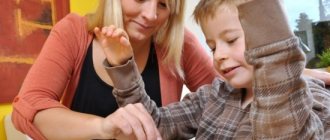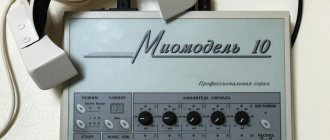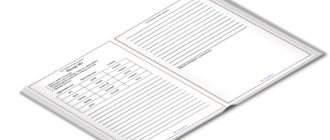Last name, first name _______ Date of birth ______ General physical development _____ Health status _____ Family composition _____
This is also important to know: How to return money to the buyer
Entered preschool educational institution____
She has been attending kindergarten since August 20__. I quickly adapted to kindergarten.
A child from a complete family. Relationships with parents are built on a warm, friendly basis. In a family, the child communicates most with his mother. At home he prefers to draw, play checkers, draw, and lego. He readily responds to his mother’s offers to help with cleaning the house. Places toys independently.
Somatic health. She rarely gets sick, has a good appetite, falls asleep quickly, and has a restful sleep.
Social skills are age appropriate. The child can independently use toiletries, wash his face, wash his hands, comb his hair, can dress, undress, put on his shoes, and use a spoon independently. The boy is aware of his physical capabilities. Aware of himself in time and space.
Features of gaming activity: the child prefers subject-based procedural and active games, participates in role-playing games, performing different roles in them. He loves to play outdoor games and cars with other children. He enjoys playing with Legos and loves listening to fairy tales.
The main difficulties noted in communication: The child has developed a friendly attitude towards children and has developed a desire to cooperate with them. Among the guys in the group there is a constant circle of friends with common interests. Willingly makes contact with adults.
Features of individual cognitive processes: The child is distinguished by a high level of development of attention, auditory and visual memory, and imagination. Visual-figurative and elements of logical thinking are quite well developed.
Speech development: The child has good speech development. Pronounces all phonemes, knows how to identify phonemes in a word. The child has a large vocabulary. Builds sentences correctly. Monologue speech predominates: correctly constructs oral messages and reasoning about ways to perform actions.
The main difficulties noted in training: The child easily masters the program; the pace of work during classes is uniform. Shows interest in activities. He enjoys his work and feels confident there. He reacts negatively to criticism, may become offended and stop completing the task. Loves praise and approval, which he tries to earn. The child's level of moral development is normal. The boy knows what is good and what is bad.
Loves to be in kindergarten. The cognitive type of communication with the teacher predominates. He understands that in kindergarten he is taught to read, draw, speak English, and dance. This is precisely why he loves his teacher.
Character traits. The boy is sociable, affectionate, friendly, touchy.
Psychologist of preschool educational institution No.___: __________________
Head of preschool institution No.___: ___________________
Psychological and pedagogical characteristics for a preschool educational institution graduate for admission to school
1st option
Full name, date of birth, address ______________
Pupils of preschool educational institution No. _______, group No. ________
Date of admission to preschool educational institution ______________
1. Information about the family: mother’s full name, year of birth, place of work; Father's full name, year of birth, place of work; conditions of education. The family is complete, incomplete, conditions are satisfactory or not, indicate the reasons for unsatisfactory conditions.
2. The stock of information about the environment ______________
3. Characteristics of cognitive processes: attention (ratio of voluntary and involuntary, concentration); memory; thinking (features of analysis, synthesis, generalization, classification, establishment of cause-and-effect relationships); sensory development (properties of objects, time orientation); speech (dictionary, grammatical structure of speech, sound pronunciation); sound-letter analysis.
4. Development of elementary mathematical concepts
5. Features of motor development (gross and fine motor skills, leading hand, presence of motor disinhibition, state of constructive and graphic skills).
6. Formation of motivation for educational activities
7. Emotional-volitional sphere and individual psychological characteristics of the child.
8. Recommendations ______________
2nd option
1. General information about the child: full name, date of birth, home address, since when he has been attending the preschool educational institution.
2. Family characteristics: parents’ full names, year of birth, place of work; family composition: complete, single-parent, large, presence of brothers and sisters; who is raising the child (mother, father, grandmother, others); whether sufficient attention is paid in the family to the upbringing and education of the child.
3. Typological features: active, mobile, sluggish, inert, slow; excitable, unbalanced, calm, balanced, inhibited, whiny; speed of reaction to verbal stimuli, switchability; the prevailing mood is cheerful, depressed, without any special shade. Do you experience sudden mood swings throughout the day? whether he persists in the face of difficulties or retreats in the face of them; whether he asks for help and uses it.
This is also important to know:
How to quickly and correctly return funds to the buyer by bank transfer
4. Characteristic features: sociability, isolation (easily makes contact, perceives the situation correctly, understands its meaning, behaves adequately, contact and communication are difficult, understanding and responding to the situation is not always or not entirely adequate, does not make contact well, has difficulty in communication, understanding the situation); attitude towards comrades (friendliness, negativism, kindness, rudeness, etc.); attitude towards leadership (desire for primacy, whether others recognize him as a leader, whether he shows organizational skills and initiative); attitude towards adults; attitude towards assignments, rewards, reprimands; what types of activities does he prefer; activity of verbal communication (corresponds to age, increased, decreased, isolation noted, negative attitude towards verbal communication); behavior (organized, sometimes does not regulate one’s behavior, constant external control is required).
5. Psychological characteristics: auditory memorization, visual memorization, tactile memorization (memorizes quickly or slowly, with difficulty, transition to long-term memory, RAM capacity: sufficient, limited, low); stability of attention (capable of long-term concentration or easily distracted); nature of distraction (distracted by stimuli, in the absence of external stimuli); switchability of attention (easy, fast, slow, difficult); distribution of attention (sufficient, difficult); general level of attention development (age-appropriate, low, unformed).
6. Level of development of mental activity: the ability to compare, classify, generalize, the ability to identify an essential feature of objects and phenomena; the ability to use techniques for memorization (mediation, grouping, associations).
7. Development of sensory functions: the state of the analyzers, the presence of generalizing ideas about shape, size, color - the concept of relativity - corresponds to age, unformed, impaired.
8. Development of imagination: brightness, liveliness, richness of imagination, ability to operate with images, in what types of activities it manifests itself (music, arts, mathematics, physical education, speech, design, etc.), age-appropriate, excessive, weakness of imagination processes.
9. Verbal part: understanding stories with hidden meanings; paired analogies; plot storytelling - nominative and communicative functions of speech; ability to maintain dialogue; speech activity is adequate to the situation and age, excessive, difficulties in initiating a speech utterance, emotional inadequacy, problems with expanded speech, difficulties in sound pronunciation, the presence of stuttering, echolalia, speech cliches, etc.
10. Performance in the classroom: active, interested, indifferent attitude; concentrated or often distracted during classes; quickly or slowly starts working; pace of work: fast, medium, slow; reasons for the slow pace of work: thinking, careful execution, decreased mental activity (lethargy, lethargy, distractibility, etc.); fatigue manifests itself in a slowdown in pace, deterioration in quality, or complete cessation of work; subjective and objective I admit! fatigue (complaints of fatigue, headache, lethargy, drowsiness, distractibility, etc.); decline in performance (in the middle of the lesson, at the end of the lesson); ability to follow instructions, ability to retain instructions for duration.
11. Arbitrariness of activity: holds the goal of the activity, outlines its plan, selects adequate means, checks the result, brings the work started to completion; often gets distracted during activities, overcomes difficulties only with psychological support, needs frequent encouragement; the activity is chaotic, ill-conceived, individual conditions of the task are lost, the result is not checked, the activity is interrupted due to difficulties, assistance is ineffective.
12. Work carried out with the child: whether developmental, correctional, accompanying work was carried out for how long, type (on the formation of spatial concepts, development of cognitive processes, emotional education, etc.); recommendations for further work; results, success, skill formation (by age, with difficulty, delayed); work with parents, family (parental attitude, success, systematicity, etc.).
* * *
And in conclusion, we bring to your attention “Portrait of a kindergarten graduate,” which can serve as a guide in determining the normal development of a child upon graduation from kindergarten and drawing up a psychological and pedagogical profile.
Organizational aspects
The document is prepared with the participation of a psychologist, speech therapist and teacher. A ready-made description of a kindergarten student is provided for:
Free legal consultation
We will answer your question in 5 minutes!
Free legal consultation We will answer your question in 5 minutes!
Call: 8 800 511-39-66
Ask a Question
- Admission to school.
- Solutions to legal issues.
- Consultations with a psychiatrist.
- Commissions for transfer to a speech therapy group or specialized educational institution.
- Children with disabilities who attend kindergarten.
- Guardianship and trusteeship authorities.
This is also important to know:
How to write a sponsorship letter for a Schengen visa
The pedagogical characteristics of a preschool educational institution student is an official document that is invalid without the signature of all persons filling out the form. The seal and signature of the head of the institution is also required.
Speech therapy examination of a child
To determine the degree of development of the speech apparatus, it is simply necessary to carry out a speech therapy examination. This is necessary to identify disorders in the field of mental development.
Speech therapy group
During a speech therapy examination, two stages of diagnosis are carried out:
- General diagnostics, in which all components of development are checked: memory, thinking, attention, spatial imagination, etc.;
- Speech diagnostics, which tests speaking, writing, reading and memory.
During the examination, in addition to the diagnosis itself, a consultation meeting with parents is held. After this, a conclusion is drawn up and, together with the parents, a further method of correcting the violations is planned.
Parent consultation
The examination itself begins with a conversation, during which the speech therapist tries to establish contact with the child, and at the same time determines whether he understands him, whether he speaks in phrases or answers in monosyllables, whether he pronounces words clearly or not. At this time, the speech therapist makes an impression of general mental development. Then, based on the conclusions made, the doctor conducts a full comprehensive diagnosis using asked questions, pictures, objects and other materials.
What is the frequency of speech therapy examination of a child?
The frequency of this diagnostic is set by the teacher individually, based on the duration of the methods used. An earlier examination takes place upon admission to school, kindergarten and as part of the educational institution's plan.
Important! This usually happens in September to schedule the curriculum for the coming academic year.
There are also identified violations that require close attention. Then a PMPC is appointed - a psychological-medical-psychological commission. In such situations, a speech therapy presentation for a preschooler at the PMPK is carried out by a special commission created, during which previously made diagnoses (usually mental retardation or delayed psychological development) are confirmed or rejected.
PMPC
Description of other character traits of the child
The document drawn up by the teacher, describing the level and degree of personal development, must indicate the child’s performance, reaction to comments and demands, ability to manage his behavior, character traits (modest, quiet, impulsive, etc.). The description of the personality of a preschooler should also reflect the state of psychophysical processes: attention (stable or not), ability to concentrate, switchability, perception of phenomena (appropriate or not for age), the child’s time representations, development of memory and verbal-logical thinking. The characteristics of the child in the preschool educational institution from the teacher must be dated. The teacher's signature is placed on the last page. The document is endorsed by the head of the preschool educational institution.
Speech therapy characteristics for a student with OHP level II
Speech therapy characterization of Igor Yu., a 2nd grade student
Date of Birth:
Speech therapy conclusion:
General speech underdevelopment of level III.
Igor has been attending speech therapy classes at Secondary School No. 1 since September 15, 2017 (second year of study).
Speech environment.
There are no speech disorders in close relatives. Igor has not missed a single speech therapy class in the current academic year; in the 2017–2021 academic year there were absences due to illness and on special days. The mother keeps in touch with the speech therapist, takes an interest in her child’s problems, and consults with a specialist. Igor does his homework together with his mother; he cannot do it on his own, since he has not yet learned to read.
General motor skills.
Delayed switching of movements, slowness, and motor awkwardness are noted. Has difficulty playing with a ball or riding a bike.
Articulatory apparatus
.
There is an incorrect arrangement of teeth. Articulatory postures when pronouncing many sounds are distorted. The volume, accuracy of movements performed and switchability suffer. Synkinesis is observed when performing some articulation exercises.
General sound of speech
.
Speech is slurred due to numerous violations of sound pronunciation, violation of the syllabic structure of the word, and agrammatisms. The statements are intonationally unexpressive. There is a slowdown in rhythm at the end of the phrase. There is no logical stress. The voice is weakly modulated, quiet.
The grammatical structure of speech.
Igor answers questions in monosyllables or in a phrase of 2-3 words.
Experiences difficulty constructing even simple sentences. Makes mistakes due to unformed lexical and grammatical aspects of speech. Agrammatisms are observed when forming adjectives from nouns (for example, “banana puree - banana puree”); in the agreement of an adjective and a noun (for example, “the girl has a blue pen”), in the agreement of nouns with the numerals 1,2,5 (for example, “5 ducklings”).
Phonemic perception, sound analysis and synthesis.
The sound-letter analysis is not formed, it confuses the concepts of “sound”, “letter”, “syllable”. It is difficult to isolate a sound from a word, for example, does not name the final vowel sound, the final consonant, does not form words from individual sounds. Igor does not determine the sequence and number of sounds in a word, or its place in the word. Makes mistakes when determining the position of a sound in the middle and at the end of a word. Phonemic representations are not formed.
Sound pronunciation.
During attendance at speech therapy classes, problematic sounds [Р], [Л], [Ль], [Ч], [Ш], [С] were identified, but they were not fixed in speech. The process of automating sounds drags on for months, since Igor has no desire to learn to speak beautifully and clearly, he does not try to say the word correctly.
Should I send my child to a speech therapy group?
Important! After a diagnosis of speech therapy is made, parents have a question: is it worth sending their child to a speech therapy group?
Very often they are afraid that during the PMPK the consultation will diagnose them with mental disorders. Firstly, this rarely happens, and secondly, early speech therapy examination of children gives a greater chance of correcting all deviations. Children are often diagnosed with FFID (phonetic-phonemic underdevelopment)
Individual lesson with a speech therapist
The effectiveness of being in a speech therapy group largely depends on the competence of the teacher and speech therapist. It is worth carefully studying the characteristics of the speech therapist teacher, whether he has received an award, and try to identify more reviews. The characteristics of a speech therapist teacher for awarding a diploma of honor are drawn up for a competent teacher with extensive work experience. It is also worth studying all the necessary documents, such as the Federal State Educational Standard (FSES).
Conclusions on the speech card of a speech therapy child
When studying the speech map, the speech therapist draws his conclusions, identifying the degree of development of the child and the level of education. Based on this, the child is assigned to the appropriate group. Often children in a speech therapy group come out more prepared for school than those in a regular group. This is achieved due to the fact that there are half as many children in this group, more attention is paid to them, classes with a speech therapist and other teachers are held every day, and the speech apparatus is constantly adjusted.
They begin to learn letter-sound analysis, sentence construction, and other skills necessary for school development earlier.
If a child has various abnormalities, the doctor refers him to a more specialized specialist. He, in turn, prescribes the necessary therapy. Timely treatment and early diagnosis can get rid of most problems with a child’s speech.
Delayed speech development (SDD)
To correctly understand what signs indicate a delay in speech development, it is necessary to know the main stages and conventional norms of speech development in young children.
The birth of a child is marked by a cry, which is the baby’s first speech reaction. A child’s cry is realized through the participation of the vocal, articulatory and respiratory sections of the speech apparatus. The time at which the cry appears (normally in the first minute), its volume and sound can tell a neonatologist a lot about the condition of the newborn. The first year of life is the preparatory (pre-speech) period, during which the child goes through the following stages:
- walking (from 2-3 months);
- babbling (from 5-6 months);
- babbling words (from 8-10 months);
- first words (at 10-12 months).
Normally, at 1 year of age, a child’s active vocabulary contains approximately 10 words consisting of repeated open syllables (ma-ma, pa-pa, ba-ba, dy-dya, etc.); in the passive dictionary - about 200 words (usually the names of everyday objects and actions). Until a certain time, the passive vocabulary (the number of words whose meaning the child understands) greatly exceeds the active vocabulary (the number of spoken words).
At approximately 1.6 - 1.8 months. the so-called “lexical explosion” begins, when words from the child’s passive vocabulary suddenly flow into the active vocabulary. For some children, the period of passive speech can last up to 2 years, but in general their speech and mental development proceeds normally. The transition to active speech in such children often occurs suddenly and soon they not only catch up with their peers who spoke early, but also surpass them in speech development.
Researchers believe that the transition to phrasal speech is possible when a child has at least 40–60 words in his active vocabulary. Therefore, by the age of 2, simple two-word sentences appear in the child’s speech, and the active vocabulary grows to 50-100 words. By the age of 2.5 years, the child begins to construct detailed sentences of 3-4 words.
In the period from 3 to 4 years, the child masters some grammatical forms, speaks in sentences united by meaning (coherent speech is formed); actively uses pronouns, adjectives, adverbs; masters grammatical categories (changing words according to numbers and genders). Vocabulary increases from 500-800 words at 3 years to 1000-1500 words at 4 years.
Experts allow deviations from the normative framework in terms of speech development by 2-3 months in girls, and by 4-5 months in boys. Only a specialist (pediatrician, pediatric neurologist, speech therapist) who has the opportunity to observe the child over time can correctly assess whether the delay in the appearance of active speech is a delay in speech development or an individual characteristic.
Characteristics of a kindergarten graduate
In such a document, it is very important to pay attention to motivation for learning and the knowledge gained. It is on the basis of this document that it will be easier for future teachers to navigate the successes of a pupil of a preschool educational institution or a group of a preschool department of a gymnasium.
- Personal data in the form of initials, address and birth information.
- Information about the number of the kindergarten and group.
- Duration of kindergarten attendance.
- Information about the child’s family, the presence of brothers and sisters is indicated.
- The initials of the parents and their places of work are indicated.
- If the family is single-parent, you need to indicate with whom the child mostly lives at the moment.
- If the family is low-income, this should also be noted.
- It is indicated how the child reacted to entering kindergarten.
- The baby's attention is described, as well as the characteristics of memory and thinking.
- The teacher focuses on describing sensory development, speech and analysis of sounds.
- Information about the child's mathematical development is provided.
- Attention is paid to motor skills, how developed they are. Which hand is the dominant one, how much the child can draw, sculpt, and so on.
- The presence or absence of motivation for educational activities is noted.
- The emotional background of the baby is indicated, as well as the psychological characteristics of a particular child.
- In the last paragraph, the teacher must give his recommendations for subsequent teaching in the first grade.
Second version of the characteristics
- General information about the child is indicated, starting with initials and ending with place of residence.
- The family is characterized. Information about parents and their places of work, family composition, and the presence of children in the form of brothers and sisters is indicated here. It is indicated who most often takes part in raising the child, and how much attention he gets from his parents.
- The child's character traits are indicated. Mobility, presence of whims, pathogens, calmness, speed of reaction, and so on are indicated. It also characterizes how cheerful, cheerful and healthy the child is.
- It describes the open or closed style of sociability, how the baby makes contact, and how adequately he reacts to current situations.
- The peculiarity of the child’s behavior in the team is indicated.
- Psychological characteristics are established. For example, the presence of auditory and visual or visual memory, tactile sensation, the presence or absence of long-term memory, working memory, and so on. Particular attention is paid to the stability of attention.
- The level of development of the thought process is indicated. How much a child can qualify the information received, generalize it, and also use it for memorization.
- The possibility of using touch functions is indicated.
- It indicates how much a child can develop his imagination. Here, attention is mainly paid to the richness of imagination, as well as the ability to present various images.
- It is indicated how the child reacts to reading fairy tales and stories, how much he can retell what he has read, and ask questions.
- It is indicated if the child has speech defects, for example, choking, speech stamps, difficulties in pronouncing certain sounds.
- It is indicated how efficient the child is during classes according to a given program. How quickly or slowly he completes the task, is he motivated.
- The performance of the activity is established. Its goal, plan, and how purposeful the child is in general are indicated.
- It is indicated what work was done with the child, whether there was any correction, as well as containment of emotional outbursts.
- How parents influenced the child's ability to learn.
- In conclusion, the teacher makes a conclusion about what approach to apply to the child when he enters first grade.





